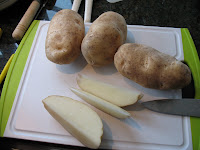In the incident that led directly to this blog post, I found myself purchasing a bottle of Colavita at Whole Foods in Washington Square, Brookline.
"Is this yours?" asked the checkout woman.
"Uhhh....yeah," I said, articulately.
In a friendly, slightly superior air: "You should put that back and get the 365 brand. It's really high quality and half the price."
I was reluctant to tell her to mind her own business, for some reason, so I ended up buying both--rationalizing my decision by hitting on the idea of a taste test.
In this highly unscientific taste test, I and one other person tasted five different olive oils.
Four of them were widely available supermarket brands: DaVinci, Filippo Berio, Colavita, and 365, the Whole Foods brand. We also added a ringer--Cook's Illustrated's favorite premium extra virgin olive oil, Columela, which I've
written about previously (same link as above).
It was a blind taste test, in which we tasted each olive oil plain, and then drizzled on some bread. Each of us then ranked the oils in order of preference, and scored them. A first place vote from a taster received 10 points, a second place vote, 8 points, a third place, 6 points, and so on.
Here are the results, from worst to first:
4th place (tie): DaVinci Extra Virgin Olive Oil, $16-$17 per liter

Both tasters were more or less in agreement on this one--this was supposed to be extra virgin olive oil? "Not a very strong flavor," wrote Taster One. "Well...it's oil," wrote Taster Two.
Taster One liked it a bit better overall, finding "nice herbal notes" when tasted straight that were masked when eaten with bread. Taster Two thought Taster One was nuts.
4th place (tie): Colavita Extra Virgin Olive Oil, $24 per liter

Both tasters found this oil strongly flavored, although they couldn't agree whether that was necessarily a good thing. Taster One found it had an "interesting musky flavor, but...not enough bite to cut through." Taster One seemed to get more and more repulsed by this oil, saying that the bread didn't "mask enough" of the flavor. "It almost tastes spoiled."
Taster Two liked it better, but found it so pungent when tasted straight that it stung the palate. "It has character...very smoky, but with green and briny accents. It's a little overwhelming...I wanted to like this more than I did." Taster Two concluded that "it could be great for dressings, salads, where you're not eating it BARE."
Although Tasters One and Two put Colavita in fifth and fourth place, respectively, based on the oil tasted straight and on bread, after the tasting, we gave it a second chance. Used in a simple vinaigrette, it held up, and gave a basic green salad a huge flavor payoff.
Colavita Fruttato (apparently a premium version of the Colavita we tasted here) was a Cook's Illustrated runner-up in their July 2008 tasting of supermarket extra virgin olive oils, for what it's worth, so that oil could definitely be worth a second look. The Cook's Illustrated
website (subscription required) doesn't note that they tasted the premium version, but the image of the bottle they used clearly says "Fruttato" on the label.
3rd place: Filippo Berio Extra Virgin Olive Oil, $14-$15 per liter

Both tasters found this oil to have a very clear flavor with a nice velvety richness to it. Taster One thought it had a "very herbal flavor, but didn't contain a lot of sweetness." Taster Two thought it was fruity and pleasant, but too mild--it lacked any real assertive, peppery, green elements. "It seems like it could be boring if you used it in a recipe rather than tasting it straight."
2nd place: 365 (Whole Foods brand), $14 per liter

This one started slow and picked up. On first taste, Taster One thought 365
"[didn't have] a strong flavor, but had a decent fruitiness." It did, Taster One noted, have enough flavor to show up well when tasted with bread. "Nice and light...with some sweetness," Taster One concluded.
Taster Two was underwhelmed at first, but then noticed some "fruitiness backed up with some assertive peppery tang....This one won me over."
For the price of $6.99 per 17-oz bottle, not a bad choice. However, the hands down winner was...
1st place: Columela Artesano Extra Virgin Olive Oil, $30-$35 per liter

There wasn't really any contest. Taster One found Columela "fruity and herbal, with a nice bite while remaining sweet enough...Not an overwhelming flavor, but held up on bread and was not too greasy or oily." Taster Two liked the "green, sharp" beginning flavor that was tangy without being overwhelming (like the Colavita). The tasters thought this was by far the most well-rounded oil, with the "best olive flavor" and balance of tangy and sweet.
So, what's the verdict?
While DaVinci and Colavita both received one fourth place and one fifth place vote each, for the remaining olive oils, the two tasters agreed right down the line the oils that were in first, second, and third place.
If you have the money, the Columela Artesano Extra Virgin Olive Oil (an unfiltered blend of four different varieties of Spanish olive) is highly recommended. It usually retails for between $15-$18 per 500-mL bottle, more than twice the price of the runner-up, 365. For my money, it's more than worth it, particularly for special occasions or dishes where the flavor of the olive oil will make a significant difference.
Both can be difficult to find. Unfiltered olive oils, although they frequently have more olive flavor than filtered versions, have a shorter shelf life because the particulate matter can speed up spoilage. This means that most supermarkets won't carry unfiltered oils, unless you happen to live in or near a place where such oils get high turnover (like, say, Brookline, home of Cook's Illustrated magazine, and foodie haven). 365 brands, on the other hand, are sold exclusively in Whole Foods stores, which might not be convenient unless you live near one--and they (ahem) also tend to congregate in areas in which might be classified as foodie havens. Or, at least, areas where people are willing to pay extra for "quality".
In that case, Columela Extra Virgin Olive Oil, the filtered version of Columela Artesano, should be available at more stores. There are also
online retailers, even Amazon, which carry olive oils, although frequently they are not particularly price-competitive, especially when you factor in shipping. Colavita, while too pungent for tasting straight, should work well in recipes that call for strong flavors.
My personal plan is to keep 365 Extra Virgin Olive Oil on hand for everyday use, and Columela Artesano for special occasions or just to eat with crusty bread from my fantastic local bakery...which is, as they say, another post.
Now I have to go back to that checkout woman at Whole Foods and pronounce my peccavi for doubting her and her "twelve years in grocery".




















 Normally in late June and early July, I would be trying to make my favorite grilled "puzzle" potatoes. (Take a potato, slice it crosswise into verrry thin pieces, keep the potato slices assembled in their original order, add a pat of butter, salt, and pepper, wrap in aluminum foil, and grill.) However, so far summer has very much failed to deliver in the weather-appropriate-to-grilling department, so, I tried a Cook's Illustrated alternative--oven fries. They came out great! These pictures really don't do them justice.
Normally in late June and early July, I would be trying to make my favorite grilled "puzzle" potatoes. (Take a potato, slice it crosswise into verrry thin pieces, keep the potato slices assembled in their original order, add a pat of butter, salt, and pepper, wrap in aluminum foil, and grill.) However, so far summer has very much failed to deliver in the weather-appropriate-to-grilling department, so, I tried a Cook's Illustrated alternative--oven fries. They came out great! These pictures really don't do them justice. Ingredients
Ingredients Directions
Directions 2. Drain potatoes. Spread potatoes out on triple layer of paper towels and thoroughly pat dry with additional paper towels. Rinse and wipe out now-empty bowl; return potatoes to bowl and toss with remaining 1 tablespoon oil. Arrange potatoes in single layer on prepared baking sheet; cover tightly with foil and bake 5 minutes. Remove foil and continue to bake until bottoms of potatoes are spotty golden brown, 15 to 20 minutes, rotating baking sheet after 10 minutes. Using metal spatula and tongs, scrape to loosen potatoes from pan, then flip each wedge, keeping potatoes in single layer. Continue baking until fries are golden and crisp, 5 to 15 minutes longer, rotating pan as needed if fries are browning unevenly.
2. Drain potatoes. Spread potatoes out on triple layer of paper towels and thoroughly pat dry with additional paper towels. Rinse and wipe out now-empty bowl; return potatoes to bowl and toss with remaining 1 tablespoon oil. Arrange potatoes in single layer on prepared baking sheet; cover tightly with foil and bake 5 minutes. Remove foil and continue to bake until bottoms of potatoes are spotty golden brown, 15 to 20 minutes, rotating baking sheet after 10 minutes. Using metal spatula and tongs, scrape to loosen potatoes from pan, then flip each wedge, keeping potatoes in single layer. Continue baking until fries are golden and crisp, 5 to 15 minutes longer, rotating pan as needed if fries are browning unevenly.













